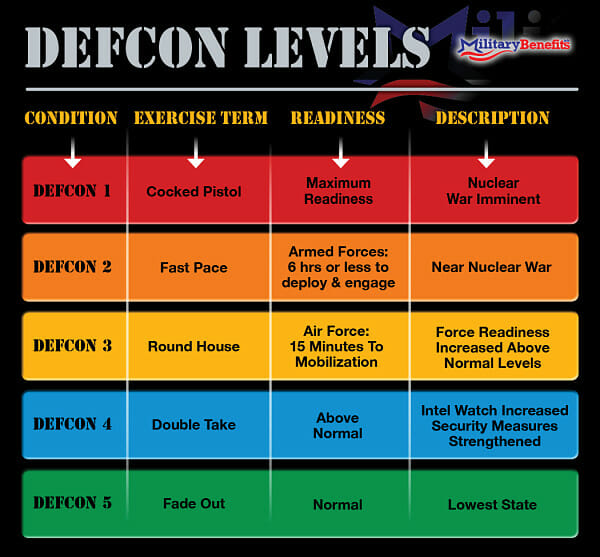DEFCON Levels
What are DEFCON levels? This system of identifying threat levels that the United States military may need to respond to is a system intended to communicate a specific level of required military readiness for an attack which may include nuclear weapons.
DEFCON levels are specifically tied to the likelihood of a nuclear threat, and since current laws of armed conflict do not prohibit the use of or development of nuclear arms, the Defense Department relies on the DEFCON system as a means to keep troops ready to meet the needs of an armed conflict or the threat of one that may include the use of nukes.
The Five DEFCON Levels
Defense Conditions, or DEFCON levels, are listed on a scale from five to one with five being “peacetime” and the top of the scale, DEFCON One being in a state of “maximum readiness.” The five DEFCON levels are:
DEFCON 1: Maximum military readiness for “immediate response” to threats or attacks
DEFCON 2: Military forces stand ready to deploy and fight in six hours or less
DEFCON 3: Select forces are ready to deploy in 15 minutes
DEFCON 4: “Above normal readiness”
DEFCON 5: “Normal”
| Readiness condition | Exercise term | Readiness | Description |
| DEFCON 1 | COCKED PISTOL | Maximum readiness. Immediate response. | Nuclear war is imminent or has already started |
| DEFCON 2 | FAST PACE | Armed forces ready to deploy and engage in less than six hours | Next step to nuclear war |
| DEFCON 3 | ROUND HOUSE | Air Force ready to mobilize in 15 minutes | Increase in force readiness above that required for normal readiness |
| DEFCON 4 | DOUBLE TAKE | Above normal readiness | Increased intelligence watch and strengthened security measures |
| DEFCON 5 | FADE OUT | Normal readiness | Lowest state of readiness |
One thing that’s important to remember about DEFCON levels is that they are also tied to specific nuclear threats. DEFCON 2 is considered just “a step away” from nuclear war, while DEFCON 1 indicates that a nuclear attack is imminent or underway.
The other DEFCON levels are designed to increase readiness up to a level that is appropriate to the threat levels without the immediate threat of a nuclear attack, but assuming a threat may still exist.
Older DoD documents from the 1990s indicate the use of something known as EMERGCONs which are specific national threat levels that reflect the reaction to an ICBM attack or potential attack.
A U.S. Navy Information Sheet for Surface Warfare Officer School Command includes the following guidance on the use of EMERGCONs:
“EMERGCONs are national level reactions in response to ICBM (missiles in the air) attack. By definition, other forces go to DEFCON 1 during an EMERGCON.” What are these EMERGCONs?
Defense Emergency: Involving a “major attack” on overseas U.S. forces or allies, “allied forces in any area, and is confirmed either by the commander of a unified or specified command or higher authority or an overt attack of any type is made upon the United States.”
Air Defense Emergency: Involves an emergency where there is an attack on the United States, Canada, or military installations in Greenland “by hostile aircraft or missiles,” which may be probable or in progress.

Source: https://militarybenefits.info/defcon-levels/